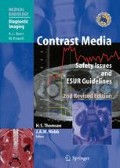There are potential risks associated with the administration of contrast agents and adverse reactions may occur. In addition, contrast agents may interact with some of the drugs and clinical tests used in the management of patients ( Thomsen 2006; Morcos 2005a,b Morcos and Thomsen 2001 Morcos et al. 2001, 2005). Although most serious reactions are observed after intravascular injection, adverse effects may also develop after oral or intra-cavitary administration because some of the contrast molecules may be absorbed into the circulation ( Morcos 2005). Reactions to contrast agents can be divided into non-renal and renal adverse reactions. Non-renal reactions may be acute (developing within 1 h of contrast agent administration) or delayed (developing after 1 h but less than a week) ( Morcos and Thomsen 2001). Some reactions, such as thyrotoxicosis and nephrogenic systemic fibrosis, may occur after 1 week and are termed very late reactions. Patients at high risk of these reactions should be identified before contrast administration to ensure that all necessary measures to reduce the risk are taken.
Access this chapter
Tax calculation will be finalised at checkout
Purchases are for personal use only
Preview
Unable to display preview. Download preview PDF.
References
Bellin MF, Webb JAW, van der Molen A, Thomsen HS, Morcos SK, Members of Contrast Media Safety Committee of European Society of Urogenital Radiology (ESUR) (2005). Safety of MR liver specific contrast media. Eur Radiol 15:1607–1614
Bostom AG, Kronenberg F, Ritz E (2002) Predictive performance of renal function equations for patients with chronic kidney disease and normal serum creatinine levels. J Am Soc Nephrol 13:2140–2144
Briguori C, Colombo A, Airoldi F et al. (2006) Gadoliniumbased contrast agent and nephrotoxicity in patients undergoing coronary artery procedures. Catheter Cardiovasc Interv 67:175–180
Ergün I, Keven K, Uruç I et al. (2006) The safety of gadolinium in patients with stage 3 and 4 renal failure. Nephrol Dial Transplant 21:697–700
McCullough PA, Wolyn R, Rocher LL et al. (1997) Acute renal failure after coronary intervention: incidence, risk factors and relationship to mortality. Am J Med 103:368–375
Morcos SK (2004) Prevention of contrast media nephrotoxicity — the story so far. Clin Radiol 59:381–389
Morcos SK (2005a) Acute serious and fatal reactions to contrast media: our current understanding. Br J Radiol 78:686–693
Morcos SK (2005b) Prevention of contrast media-induced nephrotoxicity after angiographic procedures. J Vasc Interv Radiol 16:13–23
Morcos SK, Thomsen HS (2001) Adverse reactions to iodinated contrast media. Eur Radiol 11:1267–1275
Morcos SK, Thomsen HS, Webb JAW and members of Contrast Media Safety Committee of the European Society of Urogenital Radiology (ESUR) (1999) Contrast media induced nephrotoxicity: a consensus report. Eur Radiol 9:1602–1613
Morcos SK, Thomsen HS, Webb JAW, Contrast Media Safety Committee of the European Society of Urogenital Radiology (2001) Prevention of generalized reactions to contrast media: a consensus report and guidelines. Eur Radiol 11:1720–1728
Morcos SK, Thomsen HS, Exley CM, Members of Contrast Media Safety Committee of European Society of Urogenital Radiology (ESUR) (2005) Contrast media: interaction with other drugs and clinical tests. Eur Radiol 15:1463–1468
Niendorf HP, Alhassan A, Haustein J, Clauss W, Cornelius I (1993) Safety and risk of gadolinium-DTPA: extended clinical experience after more than 5 000 000 applications. Adv MRI Contrast 2:12–19
Ros PR, Freeny PC, Harms SE, Seltzer SE et al. (1995). Hepatic MR imaging with ferumoxides: a multicenter clinical trial of the safety and efficacy in the detection of focal hepatic lesions. Radiology 196:481–488
Sam AD, Morash MD, Collins J et al. (2003) Safety of gadolinium contrast angiography in patients with chronic renal insufficiency. J Vasc Surg 38:313–318
Shellock FG, Kanal E (1999) Safety of magnetic resonance imaging contrast agents. J Magn Reson Imaging 10: 477–484
Thomsen HS (2004) Gadolinium-based contrast media may be nephrotoxic even at approved doses. Eur Radiol 14: 1654–1656
Thomsen HS (ed) (2006) Contrast media: safety issues and ESUR guidelines. Springer, Heidelberg
Thomsen HS, Almén T, Morcos SK, Members of Contrast Media Safety Committee of European Society of Urogenital Radiology (2002) Gadolinium-containing contrast media for radiographic examinations: a position paper. Eur Radiol 12:2600–2605
Thomsen HS, Morcos SK, Members of Contrast Media Safety Committee of European Society of Urogenital Radiology (ESUR) (2005) In which patients should serum-creatinine be measured before contrast medium administration? Eur Radiol 15:749–754
Webb JAW, Stacul F, Thomsen HS, Morcos SK, members of the Contrast Media Safety Committee of the European Society of Urogenital Radiology (ESUR) (2003) Late adverse reactions to intravascular iodinated contrast media. Eur Radiol 13:181–184
Zhang HL, Ersoy H, Prince MR (2006) Effects of gadopentetate dimeglumine and gadodiamide on serum calcium, magnesium, and creatinine measurements. JMRI 23:383–387
Author information
Authors and Affiliations
Editor information
Editors and Affiliations
Rights and permissions
Copyright information
© 2009 Springer-Verlag Berlin Heidelberg
About this chapter
Cite this chapter
Morcos, S.K., Bellin, M.F. (2009). Requests for Imaging Using Contrast Agents: What Information Must be Provided. In: Thomsen, H.S., Webb, J.A.W. (eds) Contrast Media. Medical Radiology. Springer, Berlin, Heidelberg. https://doi.org/10.1007/978-3-540-72784-2_2
Download citation
DOI: https://doi.org/10.1007/978-3-540-72784-2_2
Publisher Name: Springer, Berlin, Heidelberg
Print ISBN: 978-3-540-72783-5
Online ISBN: 978-3-540-72784-2
eBook Packages: MedicineMedicine (R0)

